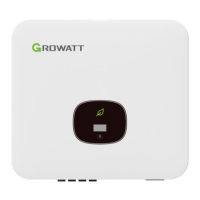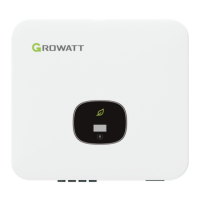Do you have a question about the Growatt MIN 6000TL-X and is the answer not in the manual?
Details the specific Growatt Inverter models covered by this manual.
Identifies the intended audience, specifying qualified personnel for installation and operation.
Directs users to additional resources and emphasizes document accessibility.
Explains the meaning of symbols used in the manual and on the product for clarity.
Defines the proper application of the inverter for grid-compliant AC power generation.
Specifies the necessary training and skills for personnel handling the inverter.
Lists essential safety precautions to be observed during installation and operation.
Details critical safety precautions to be taken during the inverter assembly process.
Highlights crucial safety warnings related to electrical connections and potential hazards.
Provides essential safety guidelines for operating the inverter safely and preventing injury.
Offers a visual identification of the inverter's main components and ports.
Explains the information provided on the inverter's identification type label.
Lists the physical dimensions and weight specifications of the inverter.
Provides guidance on the appropriate conditions for storing the inverter.
Highlights the key features and benefits that distinguish this inverter model.
Details critical safety guidelines that must be followed during the installation process.
Offers comprehensive guidance on choosing a suitable and safe location for the inverter.
Provides step-by-step instructions for securely mounting the inverter onto a wall or bracket.
Emphasizes crucial safety precautions required for all electrical connections.
Explains the procedure for correctly connecting the AC output wiring to the inverter.
Describes the process of installing a second protective conductor for enhanced safety.
Details the correct method for connecting the photovoltaic array to the inverter's DC input.
Guides on how to properly connect the signal cable for communication purposes.
Provides instructions for correctly grounding the inverter to the AC ground conductor.
Explains how to implement active power control using external measurement devices.
Details the inverter's demand response capabilities and connection requirements for DRMs.
Describes the Arc-Fault Circuit Interrupter function and its optional setup.
Outlines the initial steps and procedures for starting up the inverter.
Covers essential initial settings like display language, COM address, and date/time.
Explains advanced configuration options including country reset and export limitation settings.
Details the communication interfaces available, such as RS485 and USB ports.
Details the procedure for starting up the inverter after initial setup or shutdown.
Provides the essential steps for safely shutting down the inverter.
Guidance on how to address issues related to inverter overheating and heat dissipation.
Instructions for safely cleaning the inverter's exterior components.
Procedures for inspecting the DC disconnect for any visible damage or discoloration.
Explains common error messages displayed on the inverter's OLED screen.
Covers system-related faults, their causes, and troubleshooting steps.
Lists warning codes, their meanings, and suggested actions to resolve them.
Details inverter-specific fault codes, their descriptions, and recommended solutions.
Step-by-step instructions for safely removing the inverter from its installation.
Guidance on how to properly pack the inverter for transport or storage.
Recommendations for storing the inverter in optimal conditions.
Provides instructions for environmentally responsible disposal of the inverter.
Presents detailed technical specifications for various inverter models.
Information on the types and compatibility of DC and AC connectors used with the inverter.
Specifies the correct torque values for tightening various screws and terminals.
Lists optional accessories that can be purchased for the inverter.
| Purpose | Solar panel |
|---|---|
| Efficiency | 98.4 % |
| Input current | 27.2 A |
| Input voltage | 80 - 500 V |
| Output current | 16 A |
| Output voltage | 100 V |
| Input frequency | 50/60 Hz |
| Power supply type | Indoor |
| Power current type | DC1-to-DC2 |
| Maximum input power | 6000 W |
| Maximum input voltage | 500 V |
| Output power capacity | 6 kVA |
| Quantity per pack | 1 pc(s) |
| Product color | White |
| Depth | 350 mm |
|---|---|
| Width | 375 mm |
| Height | 160 mm |
| Weight | 10800 g |












